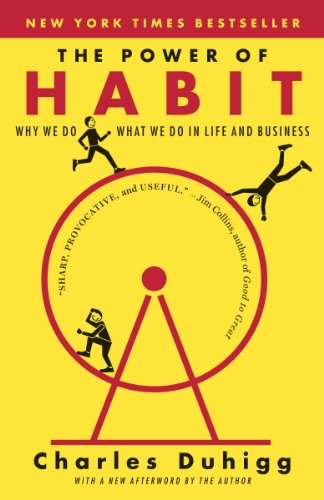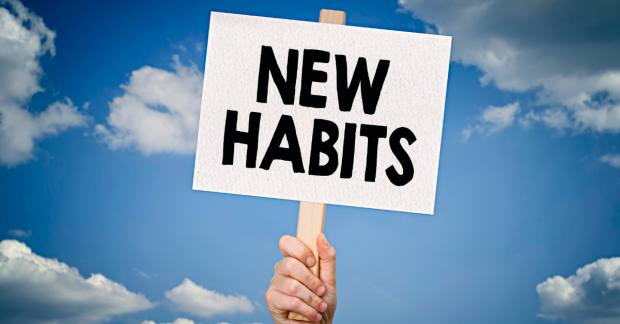The things that happen in your life today are the sum of your habits and routines. That means everything, from your happiness to your weight, result of what you do repeatedly.
Even success can happen, or not, because of your habits.
The things you spend time doing or thinking about each day create the person you are right now. That includes what you believe, and even your personality.
This means you can improve literally anything by forming new habits. When you know how to create them without forcing it, you’ll start a journey that leads to the destination you want.
People Form New Habits Form in Four Stages
The process of building new habits can be divided into four steps.
- Cues
- Cravings
- Responses
- Rewards
All habits work their way through these four consecutive stages. It is the backbone of the choices and routines people make each day.
A closer look at each stage makes it easier to understand why some habits are easier to form than others.

The Power of Habit
by Charles Duhigg
⏱ 14 minutes reading time
🎧 Audio version available
The Cue Stage
Cues trigger the brain to start a specific behavior. It is a voice that says, “If you take this action, a reward should happen.”
In the past, our basic necessities served as the primary cue. If you were hungry, you went hunting or gathered supplies. When you felt thirsty, you found water.
Today, our focus is on secondary rewards.
It might be love, approval, social status, or even money that drives the thought of a reward. Since a cue says a reward is close, it pushes the brain to progress to the next stage.
The Cravings Stage
Cravings are the motivational force behind each habit. There must be a level of desire or motivation to change, or there is no reason to act.
What people crave isn’t the new habit, but the change it delivers.
You don’t crave caffeine. What you want is the feeling that a cup of coffee offers in the morning.
Each craving links to a specific desire to change an internal state. They are different for each person because every human is unique.
That’s why one person can walk through a casino feeling bored, while another craves some time at the slots.
The craving defines the cue.
The Responsive Stage
Each response is the habit you perform. It can be a thought or an action. Whether it occurs or not depends on your motivation and any friction there is associated with the behavior.
If specific actions require more effort than you’re willing to offer, the response won’t happen.
A person’s response also depends on their ability. If someone wants to develop a habit of doing 100 pushups each day, their physical strength will limit that number during the initial response.
Habits only form when people can do them.
The Rewards Stage
Eventually, the response a person earns a reward. This goal is the purpose behind each habit and routine people establish.
The cue notices the reward, while the craving wants it. When you reach the responsive stage, it becomes necessary to earn what is desired.
We chase rewards because they teach and satisfy us. Some offer benefits by themselves, such as water quenching thirst. It can also deliver a sense of relief, because the craving is no longer present.
A reward also teaches the actions worth remembering for future needs. The human brain is a rewards detector. It constantly monitors the activities that deliver pleasure and satisfy desires.
The rewards you earn end up becoming part of a feedback system that monitors joy and disappointment, so a habit cycle forms.
How Do We Create Habits Using This Information?
When you decide to create a habit, ask yourself these four questions based on the different stages the mind uses to create change.
- How can I make it so that things are obvious?
- What can I do to make it attractive?
- How can I simplify the entire process?
- What will make the process feel satisfying?
By asking these questions, you’ll know what to do and how to do it in ways that encourage positive changes.
The first step is to start small. Work on the most obvious thing that you can improve right now. When you succeed right away, the reward outcome fuels more cues that you’ll want to attempt.
Choose one thing to be your sole focus when creating a new habit. Make it specific, measurable, and trackable, as you work toward a reward.
New habits often require us to add and subtract things from our lives. What do you need to do to make room for you to reach your new goal?
Don’t be afraid to ask “why” questions of yourself or anyone who will listen! When you start forming a new habit, it should be something you want. Far too often, those choices reflect something that people feel they need to do.
Accountability Helps the Habit Formation Process
When you want to create a new habit, it helps to tell people you trust about it. They can help you push through the difficult times when the cue and craving don’t seem to create a path toward a viable reward.
You can also adopt a commitment strategy to push yourself toward the rewards you want to experience.
The goal is to add people to your life that provide positive feedback. If you get toxic, negative energy from someone, leave them on the sidelines until you’ve reached a point in your new habit where it feels like it has stuck. When you stick with this habit-forming process over three to four weeks, you’ll notice that the transition between the four stages gets easier to complete. It won’t be long until the new habit feels like it has always been part of your daily routine!
What Is Snapreads?

With the Snapreads app, you get the key insights from the best nonfiction books in minutes, not hours or days. Our experts transform these books into quick, memorable, easy-to-understand insights you can read when you have the time or listen to them on the go.


